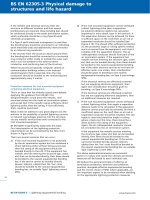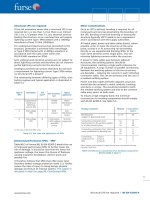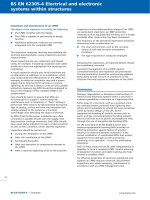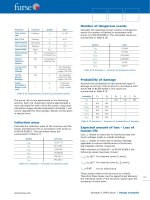Bsi bs en 00721 2004
Bạn đang xem bản rút gọn của tài liệu. Xem và tải ngay bản đầy đủ của tài liệu tại đây (519.42 KB, 14 trang )
BS EN
721:2004
BRITISH STANDARD
Leisure
accommodation
vehicles — Safety
ventilation
requirements
The European Standard EN 721:2004 has the status of a
British Standard
ICS 43.040.60; 43.100
?? ? ?????? ???? ??? ??? ?? ???????? ? ?? ? ?? ?? ?? ?????? ? ?? ? ???????? ???
?
?
?
?
?
?
?
?
?
?
BS EN 721:2004
National foreword
This British Standard is the official English language version of EN 721:2004.
It supersedes BS EN 721: 1 999 which is withdrawn.
The UK participation in its preparation was entrusted to Technical Committee
B/511, Buildings, mobile and temporary, which has the responsibility to:
—
aid enquirers to understand the text;
—
present to the responsible international/European committee any
enquiries on the interpretation, or proposals for change, and keep the
UK interests informed;
monitor related international and European developments and
promulgate them in the UK.
—
A list of organizations represented on this committee can be obtained on
request to its secretary.
Cross-references
The British Standards which implement international or European
publications referred to in this document may be found in the BSI Catalogue
under the section entitled “International Standards Correspondence Index”, or
by using the “Search” facility of the BSI Electronic Catalogue or of
British Standards Online.
This publication does not purport to include all the necessary provisions of a
contract. Users are responsible for its correct application.
Compliance with a British Standard does not of itself confer immunity
from legal obligations.
Summary of pages
This document comprises a front cover, an inside front cover, the EN title page,
pages 2 to 10, an inside back cover and a back cover.
The BSI copyright notice displayed in this document indicates when the
document was last issued.
Amendments issued since publication
This British Standard was
published under the authority
of the Standards Policy and
Strategy Committee on
17 January 2005
© BSI 17 January 2005
ISBN 0 580 45269 7
Amd. No.
Date
Comments
EN 721
EUROPEAN STANDARD
NORME EUROPÉENNE
EUROPÄISCHE NORM
September 2004
ICS 43.040.60; 43.1 00
Supersedes EN 721 :1 998
English version
Leisure accommodation vehicles - Safety ventilation
requirements
Véhicules habitables de loisirs - Exigences de ventilation
de sécurité
Bewohnbare Freizeitfahrzeuge - Anforderungen an die
Sicherheitslüftung
This European Standard was approved by CEN on 9 July 2004.
CEN members are bound to comply with the CEN/CENELEC Internal Regulations which stipulate the conditions for giving this European
Standard the status of a national standard without any alteration. Up-to-date lists and bibliographical references concerning such national
standards may be obtained on application to the Central Secretariat or to any CEN member.
This European Standard exists in three official versions (English, French, German). A version in any other language made by translation
under the responsibility of a CEN member into its own language and notified to the Central Secretariat has the same status as the official
versions.
CEN members are the national standards bodies of Austria, Belgium, Cyprus, Czech Republic, Denmark, Estonia, Finland, France,
Germany, Greece, Hungary, Iceland, Ireland, Italy, Latvia, Lithuania, Luxembourg, Malta, Netherlands, Norway, Poland, Portugal, Slovakia,
Slovenia, Spain, Sweden, Switzerland and United Kingdom.
EUROPEAN COMMITTEE FOR STANDARDIZATION
C OMITÉ EURO PÉEN DE NO RMALIS ATIO N
EUROPÄIS CHES KOMITEE FÜR NORMUNG
Management Centre: rue de Stassart, 36 B-1 050 Brussels
© 2004 CEN
All rights of exploitation in any form and by any means reserved
worldwide for CEN national Members.
Ref. No. EN 721 :2004: E
EN 721 :2004 (E)
Contents
page
Foreword ............................................................................................................................................................. 3
1
Scope...................................................................................................................................................... 4
2
Normative references ........................................................................................................................... 4
3
Terms and definitions........................................................................................................................... 4
4
Requirements ........................................................................................................................................ 5
4.1
General ................................................................................................................................................... 5
4.2
Ingress of products of combustion..................................................................................................... 5
4.3
Avoidance of obstructions................................................................................................................... 7
4.4
Ventilator grilles .................................................................................................................................... 7
5
Minimum free area of safety ventilation, by calculation ................................................................... 7
5.1
General ................................................................................................................................................... 7
5.2
Sizes of ventilation openings in habitation compartments .............................................................. 7
5.2.1 Habitation compartments containing non-room-sealed appliances ............................................... 7
5.2.2 Habitation compartments greater than 1 0 m 2 floor area................................................................... 8
5.2.3 Other habitation compartments .......................................................................................................... 8
6
Testing.................................................................................................................................................... 8
6.1
Preparation ............................................................................................................................................ 8
6.2
Procedure .............................................................................................................................................. 8
6.3
Test report ............................................................................................................................................. 9
7
User's handbook ................................................................................................................................... 9
Annex A (normative) Warning notice............................................................................................................ 1 0
2
EN 721 :2004 (E)
Foreword
This document (EN 721 :2004) has been prepared by Technical Committee CEN/TC 245 “ Leisure
accommodation vehicles”, the secretariat of which is held by BSI.
This European Standard shall be given the status of a national standard, either by publication of an
identical text or by endorsement, at the latest by March 2005, and conflicting national standards shall
be withdrawn at the latest by March 2005.
This European Standard supersedes EN 721 :1 998 “ Leisure accommodation vehicles — Safety
ventilation requirements”.
According to the CEN/CENELEC Internal Regulations, the national standards organizations of the
following countries are bound to implement this European Standard: Austria, Belgium, Cyprus, Czech
Republic, Denmark, Estonia, Finland, France, Germany, Greece, Hungary, Iceland, Ireland, Italy,
Latvia, Lithuania, Luxembourg, Malta, Netherlands, Norway, Poland, Portugal, Slovakia, Slovenia,
Spain, Sweden, Switzerland and United Kingdom.
3
EN 721 :2004 (E)
1
Scope
This document specifies the minimum safety ventilation requirements for leisure accommodation
vehicles.
It provides alternative methods of calculation or testing of safety ventilation.
2 Normative references
The following referenced documents are indispensable for the application of this document. For dated
references, only the edition cited applies. For undated references, the latest edition of the referenced
document (including any amendments) applies.
EN 624:2000, Specification for dedicated LPG appliances — Room-sealed LPG space heating
equipment for installation in vehicles and boats
EN 1 3878:2003, Leisure accommodation vehicles — Terms and definitions
3 Terms and definitions
For the purposes of this document, the terms and definitions given in EN 1 3878:2003 and the
following apply.
3.1
overall plan area
the overall plan area is measured as follows:
a) Caravan. Overall width multiplied by overall length excluding towbar;
b) Motor caravan. Overall width, excluding driving mirrors, multiplied by overall length. Where the
accommodation section is demountable, the overall plan area is the overall length of the
demountable section multiplied by the overall width;
c)
Caravan holiday home. Overall width multiplied by overall length excluding towbar. When a
caravan holiday home comprises more than one element, the overall plan area is the sum of the
areas of the separate elements before they are joined together.
3.2
model
a leisure accommodation vehicle is considered to be a different model from the tested model if any of
the following apply:
a) the exterior size and/or shape of the body is altered or in the case of a motor caravan a different
base vehicle is used;
b) the cooking appliances are situated more than 300 mm from, and/or have more burners than, the
tested model and/or any other non room sealed appliance is of a different type or position;
c)
any permanent ventilation opening in the external shell of the vehicle is of a different type or
situated more than 300 mm from its position in the tested model and/or there is consequent
obstruction of any ventilation opening;
d) the internal volume of the leisure accommodation vehicle, excluding furniture, differs by more
than 1 0 %.
4
EN 721 :2004 (E)
4 Requirements
4.1 General
Each habitable compartment, excluding toilets and bathrooms, shall be provided with safety
ventilation. A habitable compartment that includes a part that can be temporarily separated by a
curtain shall be considered as a single compartment.
The ventilation shall permit:
a) renewal of air for occupants;
b) supply of combustion air for appliances that are not room-sealed; and
c)
evacuation of the products of combustion for appliances that are not room-sealed.
This requirement shall be considered fulfilled if, for each model (see 3.2 ):
1 ) the minimum free area of safety ventilation is provided, in accordance with clause 5; or
2) the CO 2 content of the air within the habitable compartments of the leisure accommodation
vehicle does not rise by more than 1 % absolute above the background level, when tested in
accordance with clause 6 by an independent test house, and a permanent label is affixed
adjacent to the cooker (see annex A).
If when the vehicle is in motion the free area of ventilation is reduced, then as the vehicle becomes
stationary the ventilators shall automatically return to the position in which the free area of safety
ventilation was calculated in accordance with clause 5 or tested in accordance with clause 6.
4.2 Ingress of products of combustion
Flue terminals shall be sited in accordance with the appliance manufacturer's instructions preferably
on the roof or in the wall of the vehicle.
Where national legislation (see annex A of EN 624:2000) does not forbid that the flue of an appliance
is designed to discharge through the floor, precautions shall be taken to prevent ingress of the
products of combustion into the habitation area through ventilation openings in the floor. The terminal
shall be positioned as close as possible to the sides or rear of the vehicle.
NOTE
If there are underfloor flue terminals it is recommended that low level ventilation openings are
positioned in the side of the vehicle and not in the floor.
Where the underfloor area is divided into distinct channels that project below the floor, e.g. by chassis
members or floor bearers, there shall be no ventilation openings in the same channel as any flue
outlet.
Flue terminals shall not be positioned within 500 mm of a refuelling point or fuel tank breather outlet or
any ventilator from the fuel system(s).
Flue terminals positioned on a wall or a roof (except for gas appliances of not more than 30 g/h LPG
consumption) shall not be fitted within 300 mm of a ventilator for the living space or an opening part of
a window.
5
EN 721 :2004 (E)
Key
1
Ventilator
2
Prohibited zone
l = 300 mm
Figure 1 — Prohibited zone for discharge openings for the products of combustion in relation
to ventilators
Where the flue terminal of an appliance (except for gas appliances of not more than 30 g/h LPG
consumption) is positioned vertically below an opening part of a window, the appliance shall be fitted
with an automatic shut-off device to prevent operation when the window is open.
Key
1
Window
2
Prohibited zone
3
Floor
l = 300 mm
Figure 2 — Prohibited zone for discharge openings for the products of combustion in relation
to windows
6
EN 721 :2004 (E)
4.3 Avoidance of obstructions
Ventilation openings shall be positioned so that they cannot be made ineffective by drapes, curtains
or other obstructions.
If the ventilation is provided to the interior through a cupboard, bed box or similar space, it shall not be
possible for the passage of air to be obstructed inadvertently e.g. by items stored in these spaces.
4.4 Ventilator grilles
The ventilation openings shall be protected by a grille that shall be accessible for cleaning. Access
may be gained by the use of a simple tool, e.g. a screwdriver.
5 Minimum free area of safety ventilation, by calculation
5.1 General
All grilles (see 4.4) shall be accounted for when providing the minimum free area of safety ventilation.
When the high level ventilation is not provided by roof vents, the minimum high level ventilation area
shall be twice the values shown for roof vents in Table 1 . The high level ventilation openings, which
are not roof vents, shall be not less than 1 800 mm from the interior floor level of the leisure
accommodation vehicle, and in no case less than 300 mm above the upper surface of the
uncompressed mattress of the highest sleeping berth.
A combination of roof and wall vents are acceptable. To calculate the level of ventilation required,
subtract the level of ventilation given by the roof vent from the total required. Multiply the remainder by
two to give the level of ventilation required of the wall vents.
Low level ventilation openings shall be not more than 1 00 mm above the interior floor level.
5.2 Sizes of ventilation openings in habitation compartments
5.2.1
Habitation compartments containing non-room-sealed appliances
Ventilation openings shall conform to Table 1 .
Table 1 — Minimum sizes of ventilation openings in habitation compartments containing
non-room-sealed appliances
Overall plan area of leisure
accommodation vehicles
m2
up to 5
over 5 and up to 1 0
over 1 0 and up to 1 5
over 1 5 and up to 20
over 20
Minimum high level
ventilation (Roof vents)
mm 2
7 500
1 0 000
1 2 500
1 5 000
20 000
Minimum low level
ventilation
mm 2
1 000
1 500
2 000
3 000
5 000
7
EN 721 :2004 (E)
5.2.2 Habitation compartments greater than 1 0 m 2 floor area
Habitation compartments greater than 1 0 m 2 floor area, measured from wall to wall, not containing
non-room-sealed appliances shall have a minimum of 7 500 mm 2 of safety ventilation at high level, or
1 5 000 mm 2 if not by a roof vent as well as 1 000 mm 2 at low level.
5.2.3 Other habitation compartments
All habitation compartments not having a non-room-sealed appliance installed, excluding toilets and
bathrooms, shall have a minimum of 1 500 mm 2 of safety ventilation installed at high level, or
3 000 mm 2 if not by a roof vent, as well as 500 mm 2 at low level.
6 Testing
6.1 Preparation
6.1 .1
Carry out the test in a calm atmosphere with an ambient external temperature of (20 ± 5) °C.
6.1 .2 Measure the background level of CO 2 in the test area at a distance of 1 000 mm from the test
vehicle.
6.1 .3 Shut all windows, doors and manually closable ventilators and keep closed during the test
period. Open separating curtains.
Place berths in the sleeping position.
Close adjustable ventilators to their minimum position. Hermetically seal the passage of all
instrumentation services.
Switch off all mechanical ventilation systems.
6.2 Procedure
6.2.1 Measure the CO 2 level in the leisure accommodation vehicle compartments with a calibrated
apparatus. Test all compartments concurrently.
6.2.2 If a LPG refrigerator is fitted, operate the refrigerator on LPG at its maximum setting together
with any other non-room-sealed appliances, except grills, cookers or ovens.
6.2.3 To simulate occupation of the compartments, and to introduce a safety factor to cover
possible extra occupants and extended use of an unattended cooking appliance, introduce a CO 2
producing burner fuelled by propane. The output Wp of the burner shall be adjusted using the following
formula:
W
P
= 1, 2 × [(0,1 × P ) + (0,1 × N )]
(1 )
where:
W
P
p
is the output of the burner, in kilowatts
is the number of standard berths and additional berths provided by the manufacturer in the
room to be tested.
N
is the total number of burners of all grills, cookers and ovens within the room(s) to be tested.
Locate the CO 2 producing burner approximately 200 mm above floor level and take samples of the
atmosphere approximately 200 mm below the ceiling at about the centre of the compartment, where a
ventilation opening is not likely to have an undue influence, and not directly above the burner.
8
EN 721 :2004 (E)
6.2.4 Alternatively for the use of a burner fuelled by propane, CO 2 can be let directly into the leisure
accommodation vehicle.
In this case the output in kilowatts is calculated from formula (1 ) and converted into the volume of
CO 2/h in accordance with Table 2.
Introduce the CO 2 approximately 200 mm above the floor level of the vehicle.
Let the thermal output calculated from formula (1 ) into the compartment, by means of one or more
defined heating sources (e.g. heating appliance, incandescent lamp), near to the CO 2 emission point.
A fan shall not be used.
Table 2 — CO 2 volume/h at 20 °C
Height of the testing
site above sea level
CO 2 volume/h
at 20 °C
m
l/h
0
1 25
250
1 30
500
1 33
750
1 37
1 000
1 41
6.2.5 Take the first CO 2 sample after 20 min. Take subsequent samples at intervals of not less than
5 min and not more than 1 5 min. The test is completed when three consecutive readings are the
same (at which stage the CO 2 level shall be deemed constant) or if the CO 2 concentration rises by
more than 1 % absolute above the background level.
If the test is interrupted for any reason, such as opening of a door or involuntary extinguishing of a
burner, abandon the test and begin a new test cycle after a minimum period of 1 h.
6.3 Test report
A test report shall be made including the results and a statement of whether the leisure
accommodation vehicle passed or failed the tests.
7 User's handbook
Attention shall be drawn to the following in the vehicle user's handbook:
a) that the safety ventilation shall in no circumstances be obstructed, even partially;
b) the location of the safety ventilation and the need to keep screens or grilles clean and free from
dust;
c)
that appliances such as cookers with naked flames shall not be used for room heating;
d) that if the leisure accommodation vehicle has been tested and approved under clause 6, then the
text of the warning notice specified in annex A shall be reproduced in the user's handbook;
e) that is recommended, that any elevating roofs be raised when the leisure accommodation vehicle
is used for habitation purposes.
The user's handbook shall be written in at least the language of the country in which the leisure
accommodation vehicle is first sold.
9
EN 721 :2004 (E)
Annex A
(normative)
Warning notice
If the leisure accommodation vehicle is tested in accordance with clause 6, a permanent warning
notice (see Figure A.1 ) shall be affixed adjacent to the grill, cooker and oven in a position where it can
be easily seen, and in the language of the country in which the vehicle is first sold.
WARNING
When you are cooking it is essential to provide
additional ventilation, such as opening windows
near the grill, cooker and oven. Do not use
cooking appliances for space heating.
Figure A.1 — Warning notice
The lettering of the heading shall be in capital letters, not less than 6 mm in height and in the colour
red. The rest of the text shall be printed in black and no letter shall be less than 3 mm in height.
10
blank
BS EN
721:2004
BSI — British Standards Institution
BSI is the independent national body responsible for preparing
British Standards. It presents the UK view on standards in Europe and at the
international level. It is incorporated by Royal Charter.
Revisions
British Standards are updated by amendment or revision. Users of
British Standards should make sure that they possess the latest amendments or
editions.
It is the constant aim of BSI to improve the quality of our products and services.
We would be grateful if anyone finding an inaccuracy or ambiguity while using
this British Standard would inform the Secretary of the technical committee
responsible, the identity of which can be found on the inside front cover.
Tel: +44 (0)20 8996 9000. Fax: +44 (0)20 8996 7400.
BSI offers members an individual updating service called PLUS which ensures
that subscribers automatically receive the latest editions of standards.
Buying standards
Orders for all BSI, international and foreign standards publications should be
addressed to Customer Services. Tel: +44 (0)20 8996 9001.
Fax: +44 (0)20 8996 7001. Email: Standards are also
available from the BSI website at .
In response to orders for international standards, it is BSI policy to supply the
BSI implementation of those that have been published as British Standards,
unless otherwise requested.
Information on standards
BSI provides a wide range of information on national, European and
international standards through its Library and its Technical Help to Exporters
Service. Various BSI electronic information services are also available which give
details on all its products and services. Contact the Information Centre.
Tel: +44 (0)20 8996 7111. Fax: +44 (0)20 8996 7048. Email:
Subscribing members of BSI are kept up to date with standards developments
and receive substantial discounts on the purchase price of standards. For details
of these and other benefits contact Membership Administration.
Tel: +44 (0)20 8996 7002. Fax: +44 (0)20 8996 7001.
Email:
Information regarding online access to British Standards via British Standards
Online can be found at />Further information about BSI is available on the BSI website at
.
Copyright
BSI
389 Chiswick High Road
London
W4 4AL
Copyright subsists in all BSI publications. BSI also holds the copyright, in the
UK, of the publications of the international standardization bodies. Except as
permitted under the Copyright, Designs and Patents Act 1988 no extract may be
reproduced, stored in a retrieval system or transmitted in any form or by any
means – electronic, photocopying, recording or otherwise – without prior written
permission from BSI.
This does not preclude the free use, in the course of implementing the standard,
of necessary details such as symbols, and size, type or grade designations. If these
details are to be used for any other purpose than implementation then the prior
written permission of BSI must be obtained.
Details and advice can be obtained from the Copyright & Licensing Manager.
Tel: +44 (0)20 8996 7070. Fax: +44 (0)20 8996 7553.
Email:









